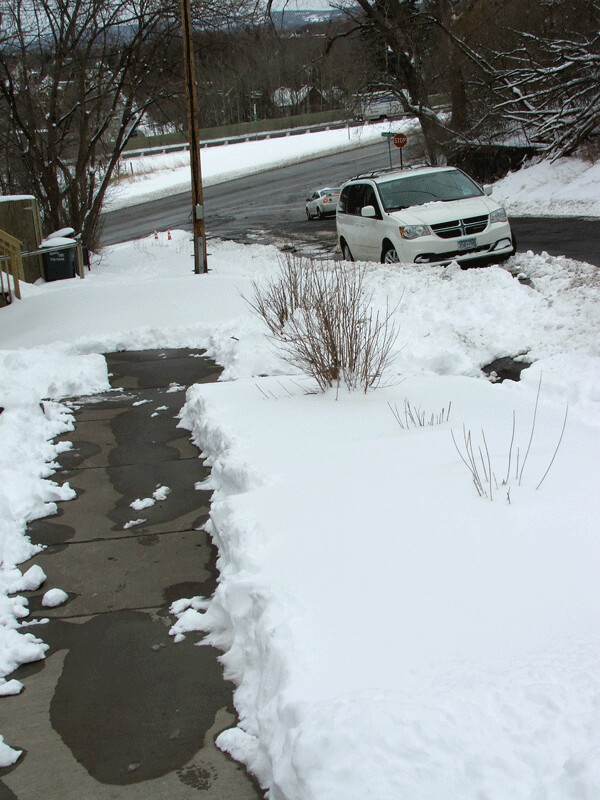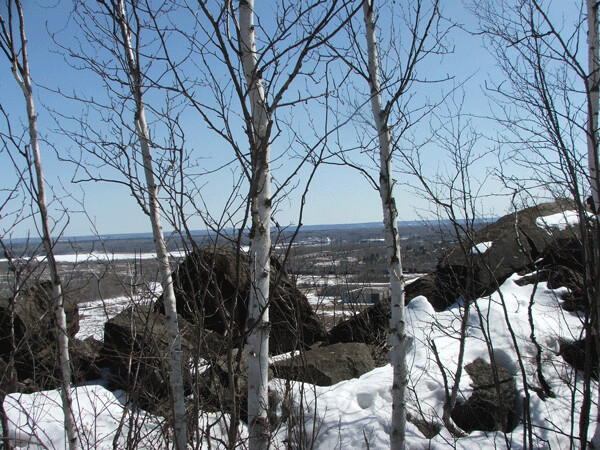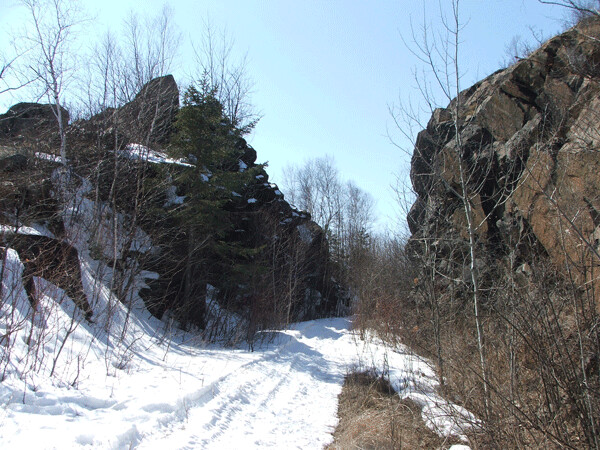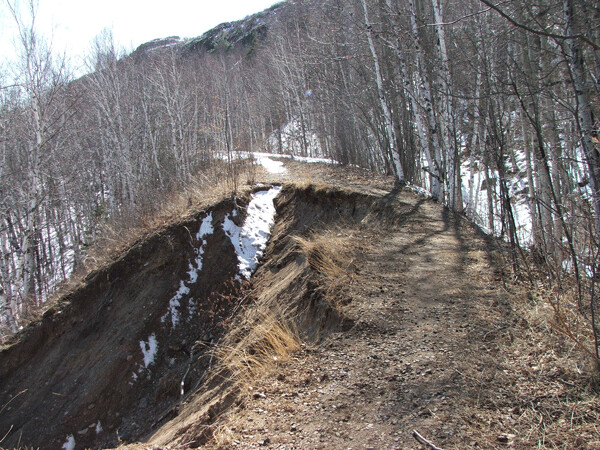City looks at snow removal changes
For the past two years, the city has been holding public forums and conducting brainstorming sessions as part of the Imagine Duluth 2035 initiative, a planning effort which is intended to guide land use decisions in the city for the next 20 years. Planners and citizens looked at housing, employment, health care and many other focus areas. In the end, however—as Planning Director Keith Hamre told the City Council at their annual retreat on March 31, 2018—one of the foremost issues that emerged from the public engagement was snow removal.
“We’d have an economic development focus group, they’d talk about snow clearing and transit,” said Hamre. “We’d have a housing meeting, they’d talk about snow clearing and transit. We’d have a transportation group, they talked about snow clearing and transit. So we kept hearing it over and over and over.”
Sidewalks are one big concern. As anyone who has lived in Duluth in the winter knows, shoveling sidewalks can be a never-ending chore. As soon as you shovel your sidewalk, a plow comes by and covers it back up with compacted snow and dirt from the street. The problem is worse if there’s no boulevard between the sidewalk and the street. Without a buffer, some homeowners can find themselves facing a solid waist-high ridge of dirty ice chunks every time the plow goes by.
Under city code, property owners must clear a three-foot path on sidewalks that abut their property. However, also under city code, the city is supposed to clear sidewalks that are buried by city plows. This is a requirement that the city is completely unable to meet. With over 400 miles of sidewalks, the city clears only a tiny percentage of them each winter, mostly around schools and high-traffic business districts.
In 2014, the city established a “tiered” priority system for sidewalk snow removal. Under the system, after every snowfall the city clears high-priority Tier One sidewalks first, Tier Two sidewalks second, and Tier Three sidewalks third. Most residential sidewalks are Tier Three, which means they never get cleared.
“Right now we’ve got 3 to 5 staff,” said Hamre. “They can get 12 to 14 miles of sidewalk cleared a day … Usually within a week’s time [after a snowfall, they] get completed with Tier One, and we sometimes get started on Tier Two, but then the next snowfall event happens and we’re back to Tier One. They never get a chance to touch Tier Three.”
So what happens when a plow buries somebody’s sidewalk, but the city doesn’t clear it? Some homeowners dutifully chop through the frozen mess, but others call it the city’s responsibility and leave it there. Some residents may be physically unable to do the heavy work, and have no choice but to leave it. Due to these and other factors, many city sidewalks go unshoveled all winter long. This, in turn, leads to pedestrians walking in the streets and (as Director Hamre put it at the council retreat) “trying to play Frogger and not get hit by cars.”
One goal of the Imagine Duluth 2035 report calls on the city to “Ensure that sidewalks and crosswalks are rapidly cleared of snow … to ensure ease of system use by all residents.” According to Hamre, the city wants to achieve this goal, which it has never been able to achieve before, by having the City Council repeal the part of the ordinance that says the city has to clear sidewalks that it buries. “The city administration is going to [ask] council that we take that out … because we’ve got to have a more coherent process on how we clear snow and how we look at sidewalks,” he said.
Of course, all responsibility for clearing the sidewalks would then shift onto adjacent property owners. As soon as that happens, the city can begin clearing sidewalks using law enforcement rather than a shovel. For example, if an elderly grandmother finds herself unable to chip away the frozen mountain range that a plow has left along two sides of her corner lot, the city will be able to nudge her along with helpful warnings and fines.
“As you think about enforcing sidewalk clearing, there’s going to be some challenges there for you,” Hamre acknowledged. “You’re going to have people who say, ‘I’ve got a disability’ or ‘I don’t have the equipment to clear the snow.’ If we’re going to be fair to everyone, we’ve got to think through some of those different aspects and how we look at that.”

As for streets…
To facilitate snow removal from the streets, the city is considering eliminating our present calendar-based alternate-side parking system and replacing it with a “snow emergency” system. Currently, cars park on one side of the street for a week, then switch to the other side of the street for the following week. This can make snow removal difficult, as plows can only clear one side of the street on any given week. Alternate-side parking also creates safety problems on Sunday, when cars are parked on both sides of the street for several hours during the switchover period. This sometimes narrows the roadway too much for plows or emergency vehicles to get through at all.
Under the snow emergency system, following a snowfall the city would declare a “snow emergency” for certain streets. All vehicles would have to be moved from those streets, and vehicles that weren’t moved would be towed. The plows would then completely clear the street (pushing huge piles of snow onto everybody’s sidewalks in the process, no doubt) and move on to the next street until the job was done. Bigger streets would be cleared this way regularly, while secondary streets would be cleared on a less frequent schedule.
The calendar-based system we use now is far from ideal, especially when one considers the hazards of the Sunday switchover time. This probably explains why few other cities use it. According to Hamre, “It’s a quirk of Duluth. It’s just something in our history…It is unusual. You don’t see calendar parking in most communities.”
Clearly, switching to a snow emergency system would involve a lot of logistics and cooperation. The learning curve probably wouldn’t be pretty. There would be a fair number of unhappy people wondering why their cars got towed. In the end, though, everybody would probably get used to it and adapt, as people tend to do. If somebody organized free parking areas in, say, city lots or church lots where people could leave their cars while the snow clearing was underway, that would certainly make things easier. I’m sure people will have other ideas.
The full Imagine Duluth 2035 report is available at imagineduluth.com, but has not yet been voted on by the City Council.



DWP reconstruction
On April 9, 2018, the Duluth City Council approved a $130,000 contract with Dirt, Inc. to do reconstruction work on the DWP trail. The money will come from the city’s half-and-half tourism tax fund, and will be matched with a grant from the federal government.
Built in 1911, the DWP trail is the old railroad bed of the Duluth Winnipeg & Pacific Railroad. It was abandoned in the 1980s, when the new freeway cut it off in West Duluth. At that time, ownership of more than 10 miles of rail corridor was turned over to the city. The line follows the escarpment below Skyline Parkway, a feat of engineering supported by steep earth embankments and blasted through rock cuts, offering miles of spectacular views of the St. Louis River estuary and Wisconsin. There’s a tunnel through Ely’s Peak and a trestle over Stewart Creek, both outstanding destination features in themselves. By many measures, especially mine, the DWP is the best trail in town.
The reconstruction work will include fixing and replacing culverts, grading the trail surface to drain water better, and removing rock falls from the trail. The biggest repair job will be rebuilding a massive washout east of the tunnel. This washout (which some might consider a destination in itself) threatens to wipe out the trail altogether. Only a remnant of railroad grade remains, two or three feet wide, for people to cross. The rest has fallen into the ravine. If the trail washed out completely, the cost to fix it would be prohibitive.
For the past two years, the city has been gathering input and thinking about the future of the DWP—primarily, which user groups it should serve. Hikers, bikers, equestrians, and ATV riders all have an interest in the trail. According to Project Coordinator Jim Shoberg at a public presentation that he gave on April 5, these deliberations are ongoing, and no final plan has been settled on. The current work is intended for “critical infrastructure repairs” which will restore the basic structural integrity of the trail in order to ensure that, whatever plan is ultimately decided on, the trail will exist to serve it.
Shoberg said that the city will continue to gather input for the DWP vision in future public meetings. “We need to engage the public and figure out, all right, now that we’ve got the base of this cake done, what’s the frosting going to look like?”